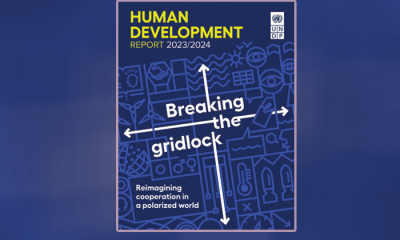Business
Government and UNDP map out SDG investment for private sector to support recovery

The Government of Sri Lanka and UNDP in Sri Lanka announced the launch of the Sri Lanka SDG Investor Map (the Map), a market intelligence tool that seeks to direct private capital where Sri Lanka’s Sustainable Development Goals (SDG) priorities, Government policy and market opportunity intersect, as the country seeks to rebuild its economy sustainably, using the SDG framework as its guide. The methodology for the Map was created by UNDP SDG Impact.
Like many other countries, the Sri Lankan economy was also impacted by the COVID-19 pandemic with GDP growth contracting 3.6% in 2020 with a significant slowdown in tourism earnings which is a key source of dollar income for the country. Sri Lanka is building pathways to recover from its double crisis of sovereign debt and a balance of payment crisis, making it difficult to import essential items such as medicines, fuel and food. The current public debt is 140% of GDP and Sri Lanka’s plan is bring it down to less than 100% by 2032.
While Sri Lanka is pursuing an IMF program to stabilize its macro-economy and restructure its external debt, private capital, foreign direct investments, blended finance options and public-private partnerships, are all needed. The SDG Investor Map will be of importance when channeling these funds to investments for social and environmental objectives- towards green development, women’s economic empowerment, social sector development (example: health).
The Map will be a crucial tool to accelerate Sri Lanka’s recovery pathway and build forward better. The Map can be used by:
Investors wishing to explore Sri Lanka as an investment destination while also rendering benefits for local communities and the environment
Enterprises that want to adjust their business strategy towards inclusive models and are seeking market intelligence and investment rationale to validate their approach
Government agencies seeking to address entry level barriers for the private sector and to build an amenable ecosystem for the development of SDG enabling sectors
In Sri Lanka, the Map was the result of a strong collaboration between UNDP and Sri Lanka’s Sustainable Development Council, the nodal government institution responsible for coordination, facilitation, monitoring, evaluation and reporting on the implementation of the 2030 Agenda for Sustainable Development in Sri Lanka. Sri Lanka’s apex investment promotion agency, the Board of Investments (BOI) of Sri Lanka, also provided input and validation during the development of the Map and is a key partner for the Map’s launch. Through secondary research and over 50 consultations with public and private sector organizations, the Map has identified 15 Investment Opportunity Areas (IOAs) that cover investment themes and business models across 5 SDG priority sectors: Renewable Energy, Healthcare, Infrastructure, Food & Beverages and Consumer Goods.
At the event, UNDP called on the private sector to adopt the SDG Impact Standards, the independent and global management standards that guide businesses and investors in their decisions to optimize interrelated economic, social and environmental impacts. The forthcoming SDG Impact Standards Assurance Framework and SDG Impact Seal recognizes investors and enterprises who are more likely to be contributing positively to sustainability, reducing the risk of impact-washing.
Speaking at the event, Mr. W.A. Sarath Kumara, Deputy Secretary Treasury, Ministry of Finance stated, “Sri Lanka’s commitment to achieving the SDGs is explicit in our continued pursuit of national policies and development plans and programmes in alignment with SDGs over the years. Innovative financing mechanisms become imperative to synergize the government, private sector, and capital markets to generate the additional resources needed to finance the SDGs. The SDG Investor Map is therefore a timely intervention that would provide the potential investors with the required market information relating to potential investment opportunity areas.”
Highlighting how the map will inform Sri Lanka’s efforts to rebuild its economy sustainably, H.E. Ms. Hanaa Singer-Hamdy, Resident Coordinator, United Nations in Sri Lanka, said “a whole-of-society approach is needed to mitigate the immediate impacts of Sri Lanka’s economic crisis and assure the country’s long-term sustainable development. The Sri Lanka SDG Investor Map offers a compelling pathway for private sector entities to increase the alignment of their investments with the SDGs. It complements the recently launched United Nations Sustainable Development Cooperation Framework 2023–2027 by translating relevant country-level SDG gaps and priorities into private sector investment opportunities that will have lasting impacts on lives and livelihoods across the country.”
Commenting on the collaboration, Ms. Chamindry Saparamadu, Director General, Sustainable Development Council stated, ‘Partnerships underpin the success of the 2030 Agenda for Sustainable Development. Each stakeholder has particular strengths to bring to bear in delivering on the SDGs. Partnership and collaboration between the Sustainable Development Council and the UNDP in creating Sri Lanka’s first ever SDG Investor Map provides a classic example of how the strengths of each agency was leveraged to produce an innovative solution that could help bridge the financing gap for SDGs in Sri Lanka’.
Highlighting UNDPs role, Ms. Malin Herwig, Officer-In-Charge, UNDP in Sri Lanka commented, “The SDG Investor Map has provided us market intelligence on SDG aligned investment opportunities for Sri Lanka at this critical juncture. UNDP together with the Government of Sri Lanka, through the Map, calls for development partners, IFIs and private impact investors to come together to formulate financing solutions to contribute to the country’s recovery and SDG acceleration.”
Ms Fabienne Michaux, Director of SDG Impact concluded, “While there is much to be done, there is a great opportunity for the private sector to integrate sustainability and the SDGs into their investments and businesses to help Sri Lanka build forward better. The Sri Lanka SDG Investor Map has done a large part of the leg-work by identifying those sectors that will have the most development impact and that are aligned to the Government’s SDG targets. This coupled with the adoption of the SDG Impact Standards which guides the private sector to manage their impact, will further the country’s ability to build a more resilient future, leaving no one behind”.
Business
CSE launches XBRL system to enhance financial reporting for listed companies

The Colombo Stock Exchange (CSE), in collaboration with the Securities and Exchange Commission of Sri Lanka (SEC) and the Institute of Chartered Accountants of Sri Lanka (CA Sri Lanka), has embarked on a significant initiative to introduce the eXtensible Business Reporting Language (XBRL) for listed entities in Sri Lanka. This move is expected to transform the way financial data is submitted, analyzed, and disseminated within the capital market.
XBRL is a global standard for digital reporting, specifically for financial business data. XBRL is the universal language for business data reporting and standardizes communication of financial reporting. It enhances data accuracy, simplifies reporting, and allows for more effective analysis and faster comparison of financial information by businesses, regulators, researchers, investors, and other stakeholders.
The primary objective of this initiative is to streamline the submission of financial and non-financial information of listed companies set out in the Interim Financial Statements and Annual Reports by listed companies in compliance with the XBRL taxonomy, ensuring a more efficient and effective dissemination of financial data to the market. The XBRL taxonomy would be developed jointly with CA Sri Lanka and SEC.
The CSE formally marked the beginning of this journey by signing a contract agreement with Microvista Technologies (Pvt) Ltd, India on 9th April 2025, to develop the XBRL system. Microvista Technologies (Pvt) Ltd is a leading compliance platform provider in India possessing extensive experience in XBRL based financial reporting implementations. A demonstration of the proposed system was held at the CSE premises for 30 selected listed companies, representing the banking, insurance, and other sectors. This session provided companies with a first look at the system’s interface and functionality, followed by a Q&A forum to gather initial feedback. The CSE will conduct awareness sessions for Listed Entities through a structured engagement framework.
CSE intends to adopt a phased approach for the implementation of XBRL based financial reporting. In phase one, CSE plans to convert Interim Financial Statements into XBRL based digital financial reporting in early 2026. Upon successful adaptation of phase one by the listed companies, the CSE envisions expanding the scope of XBRL based financial reporting to Annual Reports by 2027 and the submission of Sustainability Reports by 2028.
The adoption of XBRL brings a multitude of benefits to listed entities and market stakeholders. Built-in validation tools help identify inconsistencies or omissions, while the automated system facilitates faster and streamlined financial reporting. Tagged data can be reused across multiple platforms and reports, reducing duplication in data entry and significantly lowering compliance costs.
The implementation of XBRL supports transparency and increases capital market efficiency by helping users of business and financial information locate relevant details. For example, companies reporting under a common taxonomy provide specific details that are immediately comparable by investors and analysts in investment decision-making. XBRL enables listed companies to switch resources away from costly manual processes, typically involving time-consuming comparison, assembly and re-entry of data. Instead, they are able to redirect more effort on analysis, supported by software, which can validate and manipulate XBRL information.
Compared to manual data entry and analysis, XBRL would increase the accuracy of information and enable more value-added analysis, review, and decision-making. It also enhances data analytics capabilities for both regulators and investors, while improving accessibility to a wider pool of international investors through cross-border comparability. XBRL filing provides a reduction in total costs over the long term. This can benefit the organization in various ways, such as improved investor relations, investor coverage, and access to capital markets. Since, XBRL is a widely accepted filing approach adopted by many jurisdictions, many foreign portfolio investors are already used to XBRL formats. As such, they would prefer financial statements published in XBRL for their analytical purposes.
This strategic initiative by the CSE reinforces their shared commitment to modernizing financial reporting infrastructure and aligning Sri Lanka’s capital market with international best practices in transparency, accuracy, and accessibility.
Business
External market factors propel CSE to a position of relative strength

Investor sentiment at the CSE became more positive yesterday and the market moved to a very healthy position due to external market factors.Investors were more optimistic about the government’s efforts succeeding in negotiating with the US authorities to get a concessionary arrangement from US’ reciprocal tariff increase of 46 percent on US exports, market analysts said.
Amid those developments both indices moved upwards. The All Share Price Index moved up by 155 points, while the S and P SL20 rose by 38.9 points. Turnover stood at Rs 2.4 billion with seven crossings.
Those crossings were reported in JKH which crossed 8 million shares to the tune of Rs 160 million; its shares traded at Rs 20, Hemas Holdings 500,000 shares crossed to the tune of Rs 60.2 million and its shares sold at 120.50, Access Engineering 1.5 million shares crossed for Rs 60 million; its shares traded at Rs 40, Agarapathana Plantations 2.5 million shares crossed for Rs 41.2 million; its shares traded at Rs 16.50, Lanka IOC 300,000 shares crossed to the tune of Rs 39 million; its shares traded at Rs 130, Commercial Bank 212,000 shares crossed for Rs 29.1 million; its shares traded at Rs 137 and LB Finance 220,000 shares crossed for Rs 20.4 million; its shares sold at Rs 93.
In the retail market top six companies that mainly contributed to the turnover were; Sunshine Holdings Rs 177 million (7.6 million shares traded), JKH Rs 123 million (6.1 million shares traded), Swisstec Rs 116 million (2.3 million shares traded), Access Engineering Rs 100 million (2.1 million shares traded) Agarapathana Plantations Rs 100 million (6.1 million shares traded) and Hemas Holdings Rs 96 million (804,000 shares traded).During the day 125 million shares volumes changed hands in 17000 transactions.
It is said that manufacturing sector counters led the market, especially with JKH, while services sector and plantations sector counters performed well too.
Yesterday, the rupee opened stronger at Rs 299.60/80 to the US dollar in the spot market dealers said, while bond yields continued to fall.
The expectation of some sort of resolution to the US- China trade conflict was contributing to the positive momentum, dealers said.
Excess liquidity was also coming back to the market, after a festival drawdown.
A bond maturing on 15.12.2026 was quoted at 8.90/9.00 and closed at 8.85/98 percent down from 8.88/9.00 percent Wednesday.
By Hiran H Senewiratne
Business
Uber supported economic growth in Sri Lanka with LKR 160 billion of economic activity in 2024: Report

Uber has released findings from its 2024 Sri Lanka Economic Impact Report, compiled by global policy research firm Public First. The report highlights how Uber and Uber Eats together contributed LKR 160 billion in economic activity last year—underscoring their growing role in delivering flexible earning opportunities, expanding access to safer, affordable transportation, and helping local businesses reach more customers.
Uber has transformed the way people travel and order food, groceries and more, over the last few years. By making transportation and delivery services safer and accessible, the company has helped generate economic growth at a time when Sri Lanka has been emerging from financial uncertainty.
Uber’s operations are fueling far-reaching economic benefits across Sri Lanka. In 2024, the platform generated LKR 338 billion in consumer surplus and LKR 16 billion in added tourism value, while drivers and delivery partners reinvested LKR 660 million into local maintenance services. These figures reflect how Uber’s ecosystem is stimulating secondary markets and enabling value far beyond the digital space.
Complementing this economic uplift, Uber has empowered drivers with more stable incomes, and given 70% of them a crucial buffer during tough times. Uber Eats helped local merchants generate LKR 3.6 billion in new business, while affordable transport options allowed thousands of users to save time, budget, and enjoy safer journeys—even during emergencies.
-

 News6 days ago
News6 days agoFamily discovers rare species thought to be extinct for over a century in home garden
-

 Features4 days ago
Features4 days agoRuGoesWild: Taking science into the wild — and into the hearts of Sri Lankans
-

 Foreign News7 days ago
Foreign News7 days agoChina races robots against humans in Beijing half marathon
-

 News4 days ago
News4 days agoOrders under the provisions of the Prevention of Corruptions Act No. 9 of 2023 for concurrence of parliament
-

 Features5 days ago
Features5 days agoNew species of Bronzeback snake, discovered in Sri Lanka
-

 Features6 days ago
Features6 days agoThe ironies of history
-

 News3 days ago
News3 days agoProf. Rambukwella passes away
-

 News5 days ago
News5 days agoPhoto of Sacred tooth relic: CID launches probe
























